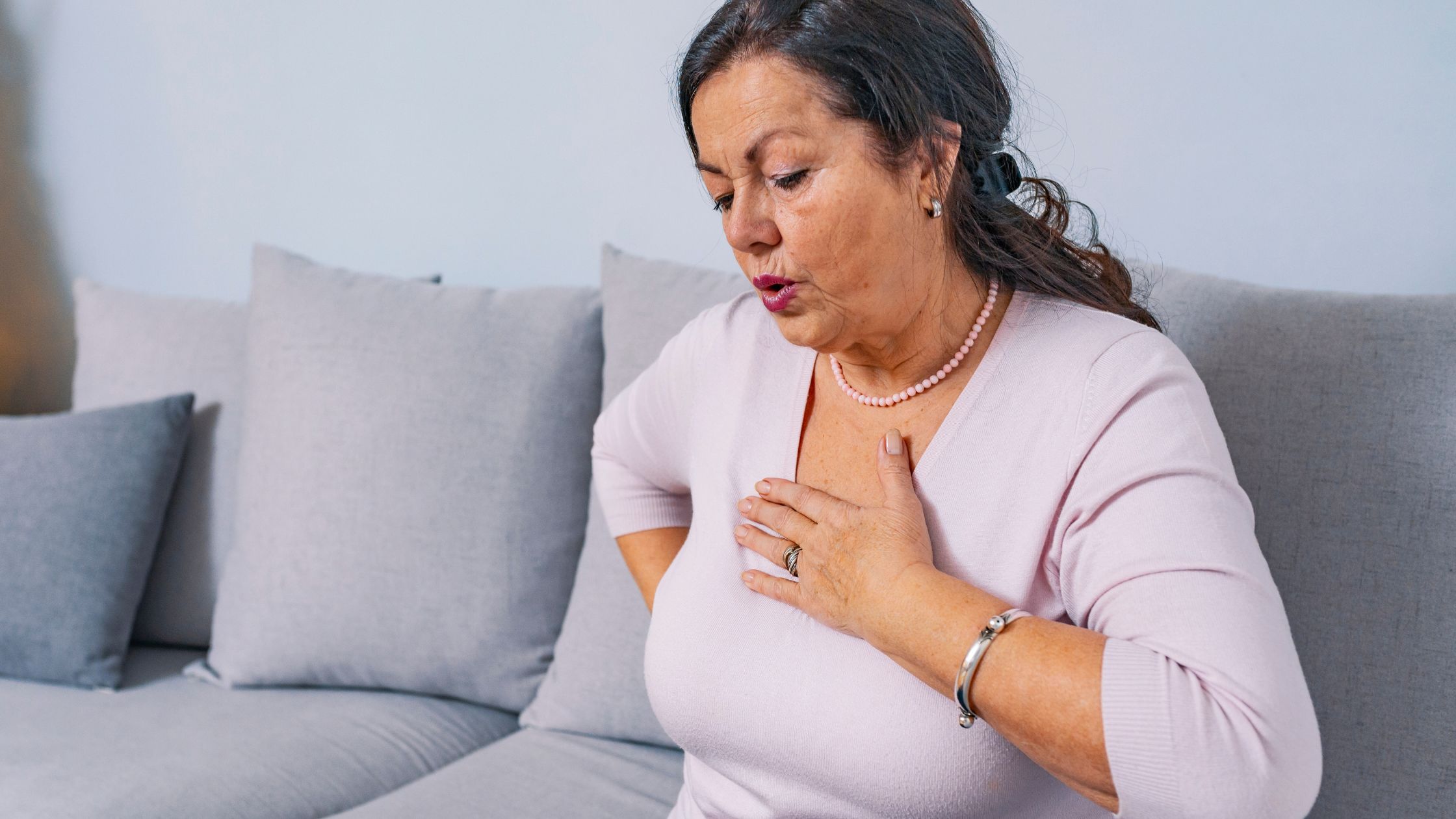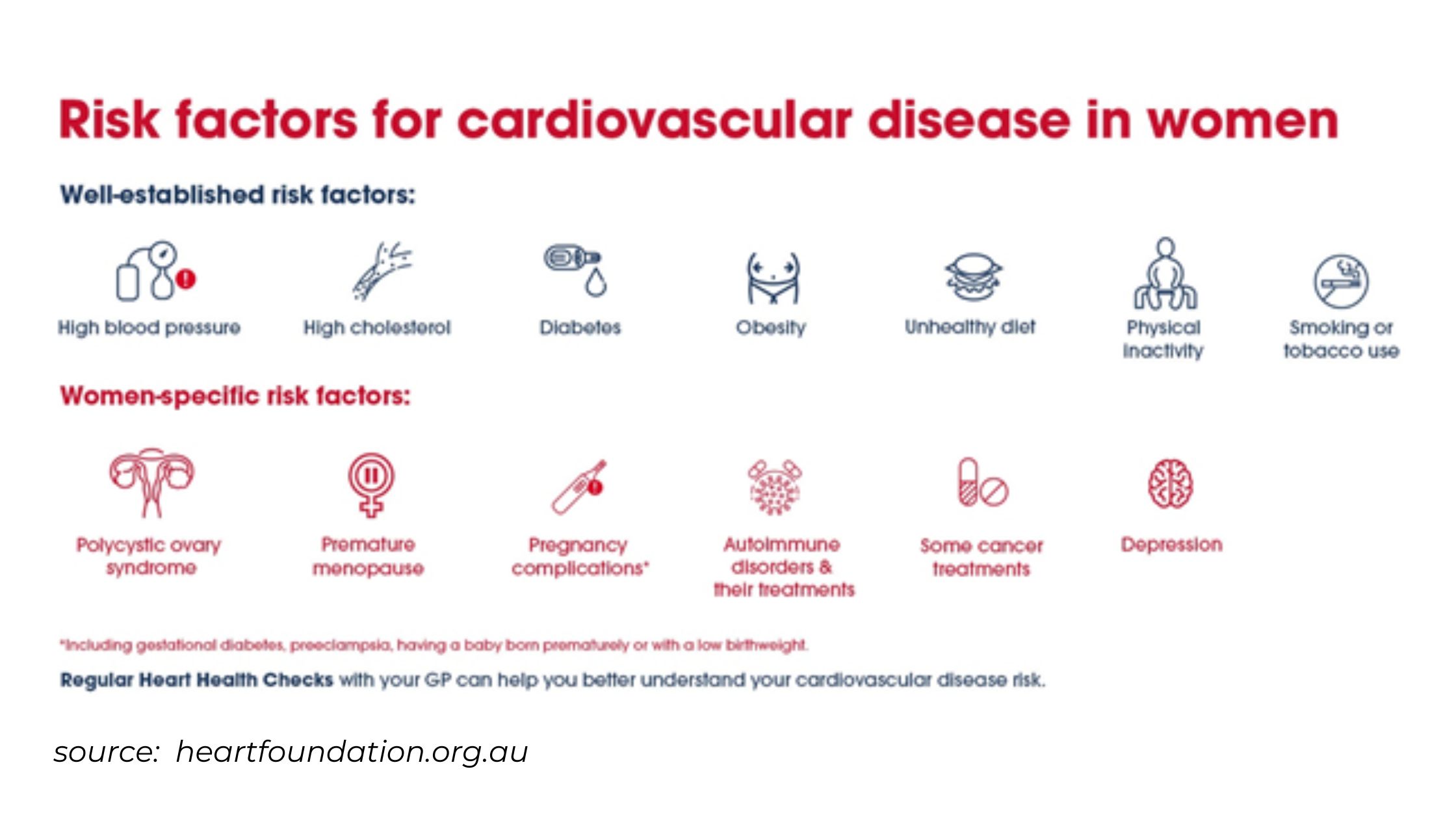Sally (not her real name), aged 61, and I caught up in my clinic after her discharge from the hospital after treatment for a heart attack. She recalls that she had delayed calling the ambulance.
“I know my chest hurt a bit, but I was feeling more nauseated than anything else and wanted to be sick like I wanted to vomit. I wasn’t feeling great, but I didn’t want to be a bother. I didn’t want to worry anyone or look like I was making a fuss. It had started after dinner, and I thought it was just indigestion or reflux or something, “ she said.
Thankfully, Sally’s daughter-in-law convinced her to call the ambulance when she mentioned that her arm was starting to go numb. Otherwise, it may have been too late for her.
For decades, heart disease has been painted primarily as a ‘man’s disease’. This stereotype, prevalent even in medical literature and mainstream media, has obscured the grim reality that heart disease is the leading cause of death for women in Australia. According to the Heart Foundation Australia, one Australian woman dies of coronary heart disease every hour. That means, that on average, twenty women die of heart disease every day. The disparity between public perception and reality raises serious concerns about the recognition, prevention, and treatment of heart disease in women. This is the reason that I am writing this today.
Understanding Heart Attacks
A heart attack, medically known as a myocardial infarction, happens when certain areas of the heart muscle do not receive an adequate supply of oxygen. The heart is a crucial organ that pumps oxygen and nutrients throughout the body via the bloodstream.
For the heart to function properly, it requires a healthy blood flow. However, if there is a blockage or reduced blood flow in the coronary arteries, which supply the heart muscle, it can result in damage or death of the heart tissue. This can lead to symptoms such as chest pain or angina. The longer the heart remains deprived of sufficient blood circulation, the higher the likelihood of experiencing serious cardiac issues, which can become life-threatening.
Symptoms: Recognizing the Unrecognized

A key challenge in combating heart disease among women is the recognition of symptoms. In men, heart disease symptoms are often dramatic— the Hollywood ‘clutching the hand to the chest’ of acute chest pain radiating down the arm, for instance. And while chest pain is indeed the most common heart attack symptom affecting up to 87% of women and up to 90% of men, women are more likely to experience non-chest pain symptoms.
One reason why women experience other things besides chest pain during a heart attack is because women are more prone to suffering small vessel heart disease. Small vessel heart disease, or coronary microvascular disease, is a complication where the blockage occurs in the smaller coronary artery blood vessels.
In contrast to men, women’s symptoms can be subtler and easily misinterpreted. Chest discomfort is common in women, but so are less typical signs like jaw, shoulder, or back pain, fatigue or tiredness, nausea or vomiting, shortness of breath or difficulty in breathing, indigestion or heartburn.
Research published in the Medical Journal of Australia revealed that these atypical symptoms in women could contribute to delayed diagnosis and treatment, thereby increasing the risk of severe complications and death. This highlights the urgency of raising public and professional awareness about the diverse manifestations of heart disease in women.
What To Do If You’re Experiencing A Heart Attack?
If you or someone you know are experiencing unusual symptoms and think it might be a heart attack, do not delay seeking help. Depending on the severity of your condition, treatment options like medication, coronary bypass surgery, and angioplasty may be recommended by your doctor to resolve your heart condition. But it’s crucial that you call the emergency hotline in your area as soon as you experience any symptoms.
Risk Factors: The Hidden Threats
According to the Heart Foundation, approximately 90% of Australian women have at least one risk factor for heart disease. These factors include high blood pressure, high cholesterol, smoking, diabetes, and obesity. Some risk factors are particularly pertinent to women. For example, many, but not all studies suggest that women with polycystic ovary syndrome (PCOS) or those with complications during pregnancy such as gestational diabetes or pre-eclampsia have a higher risk of developing heart disease.
Furthermore, specific groups of women face higher risks. Women over the age of 55 and post-menopausal women are more likely to develop heart disease due to the decrease in natural oestrogen protection. Women with a family history of heart disease must also be extra vigilant.
Perception vs. Reality: The Awareness Gap
Despite the significant threat that heart disease poses to women, many remain unaware of their risk. Because of the gender gap in medical care and the lack of education, symptoms are often dismissed. The sad reality is that because most symptoms experienced by women are far from the usual indications of a heart attack, it’s often unattended, misdiagnosed, or mistaken for a different issue like stress or anxiety.
In fact, a national survey conducted among 2,000 women across the US found that only 18% of the participants correctly identified nausea and 39% shortness of breath as atypical heart attack signs. In another study involving 218 individuals admitted to four New York City hospitals for angioplasty treatment for their heart attack, it was found that women were more likely to put off seeking help because they didn’t think that they were experiencing a heart attack.
Data from the Heart Research Institute found that cardiovascular diseases are among the primary causes of death among Australian women, where about 22,000 deaths occur yearly. In the United States, the Centers for Disease Control and Prevention (CDC) also found that more than 60 million women are coping with a heart condition of some kind. However, only about half of them recognize its life-threatening risk to their health.
Psychological And Social Factors
Psychological and societal variables also have a role in women’s lack of understanding of their cardiac risk. While many people’s first instinct is to ask for help from a medical professional whenever in pain, that is not the case for most women. As it happens, women are found to be among the late presenters in seeking medical care.
But why do women find it difficult to ask for help? The answer is that they are often used to keeping things to themselves. Believe it or not, a study involving 194 people confirmed to have suffered a heart attack actually reported that women were more likely to delay calling an ambulance than men because they didn’t want to bother anyone. Instead, they’d rather resolve whatever pain they were dealing with through self-medication.

Additionally, other coping strategies like waiting, resting, and consulting others for advice were other things women did to delay their need for medical attention. Not only because most women didn’t want to be misdiagnosed but also in fear that their symptoms don’t match their expectations.
Researchers, however, found that delaying medical attention for a type of heart attack called a STEMI (ST elevation Myocardial Infarction) increased women’s risk of dying within 30 days than men. But, when patients had a delay of less than or equal to one hour from symptom onset to hospital presentation, there was no observed sex difference in mortality rates.
Awareness and Prevention are Better Than Cure
The good news is that heart disease is largely preventable. While factors such as age and family history cannot be changed, many other risk factors are modifiable. Here are some strategies every woman can adopt to protect her heart:
Sally is only one of the many women we can save if we continue to help increase awareness about heart attacks among women. Ultimately, information about our heart health is something that everyone, regardless of gender, should learn about. But we women need to remember never to dismiss any complication we may be experiencing, as it’s best to treat it as early as possible.
Physical Activity
Regular physical activity reduces the risk of heart disease. The Heart Foundation recommends at least 150 minutes of moderate-intensity such as brisk walking, riding a bike, or dancing, or 75 minutes of vigorous-intensity physical activity each week. A simple way to measure moderate-intensity activity is if you can talk but not sing. When you are engaged in vigorous-intensity exercise, you will not be able to say more than a few words without needing to pause for breath.
Balanced Diet
A heart-healthy diet rich in fruits, vegetables, lean proteins, and whole grains can help lower cholesterol levels and blood pressure.
Stress Management
Chronic stress is linked to heart disease. Techniques such as meditation, yoga, and deep breathing can help manage stress levels.
Smoking Cessation
Smoking is a significant risk factor for heart disease. Quitting not only reduces the risk of heart disease but also offers many other health benefits.
Regular Check-ups
Regular health screenings can detect risk factors like high blood pressure and high cholesterol early. Early detection and management can prevent the development of heart disease.
Heart Diseases Are Preventable
Take note that most heart diseases are preventable, and we can only reduce the risk of hospitalization if we take the time to listen and focus on what our body needs. So, make sure you get regular health checkups, eat a proper diet, don’t hesitate to ask your doctors, and always practice a healthy lifestyle.
And remember, if you’re 30 and over and of Aboriginal or Torres Strait Islander descent, you are eligible for an annual Heart Health Check. Visit the Heart Foundation website today for more details.
This blog post is intended to spread awareness about heart disease in women and does not replace professional medical advice. Please consult your healthcare provider for personalized medical advice.
References:
Heart Foundation. (2022). Women and Heart Disease. Retrieved from https://www.heartfoundation.org.au/conditions/women-and-heart-disease
Kreatsoulas, C., & Anand, S.S. (2010). Men Versus Women: The Symptoms, Paradox, and Management of Coronary Artery Disease. Current Cardiology Reviews, 6(2), 127-134. DOI: 10.2174/157340310791162712
Lowres, N., Neubeck, L., Redfern, J., & Freedman, S.B. (2014). Screening to Identify Unknown Atrial Fibrillation. Thrombosis and Haemostasis, 112(08), 1112-1117. DOI: 10.1160/TH14-03-0231
Australian Institute of Health and Welfare. (2019). Cardiovascular disease. Retrieved from https://www.aihw.gov.au/reports/heart-stroke-vascular-disease/cardiovascular-health-compendium
Guan, C., Zahid, S., Minhas, A. S., Ouyang, P., Vaught, A., Baker, V. L., & Michos, E. D. (2022). Polycystic ovary syndrome: a “risk-enhancing” factor for cardiovascular disease. Fertility and sterility, 117(5), 924–935. https://doi.org/10.1016/j.fertnstert.2022.03.009
Heart Foundation. (2021). Physical Activity. Retrieved from https://www.heartfoundation.org.au/heart-health-education/physical-activity-and-exercise
Heart Foundation. (2021). Healthy Eating. Retrieved from https://www.heartfoundation.org.au/healthy-eating
Dimsdale, J.E. (2008). Psychological Stress and Cardiovascular Disease. Journal of the American College of Cardiology, 51(13), 1237-1246. DOI: 10.1016/j.jacc.2007.12.024
Heart Foundation. (2021). Smoking, heart disease and stroke. Retrieved from https://www.heartfoundation.org.au/heart-health-education/smoking-heart-disease-and-stroke
Kramer, C. K., Campbell, S., & Retnakaran, R. (2019). Gestational diabetes and the risk of cardiovascular disease in women: a systematic review and meta-analysis. Diabetologia, 62(6), 905–914. https://doi.org/10.1007/s00125-019-4840-2
Medical Journal of Australia. (2016). Gender disparities in the presentation, management and outcomes of acute coronary syndrome patients: data from the Australian and New Zealand Audit of Acute Coronary Syndromes. DOI: 10.5694/mja16.00195


